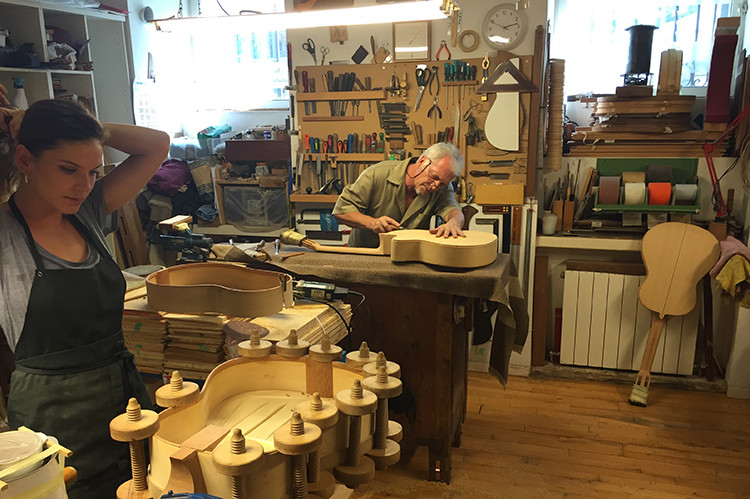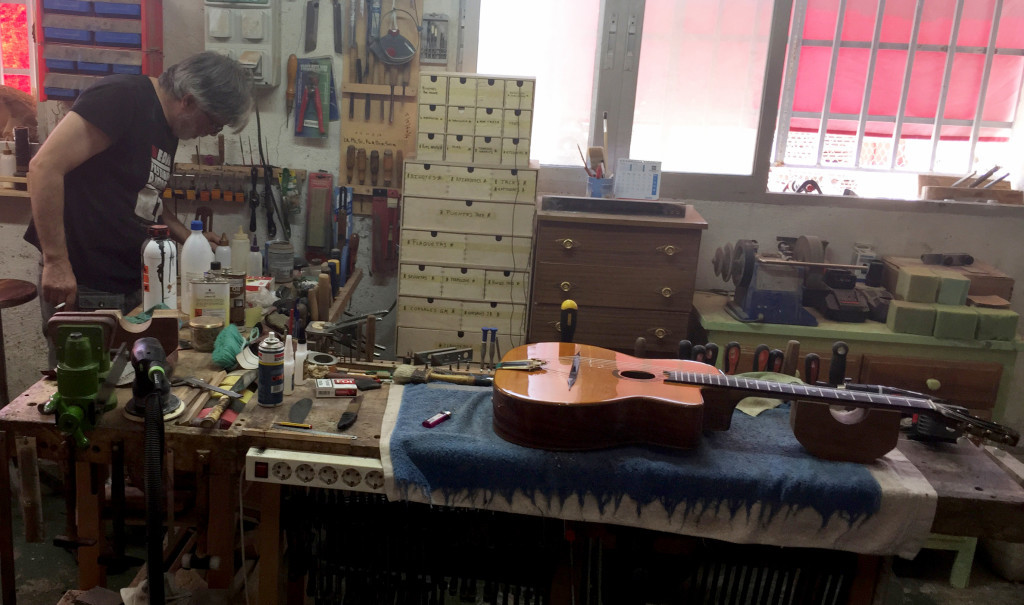Madrid, the vibrant capital of Spain, has been synonymous with exceptional guitar making since the 18th century. While exquisite classical and flamenco guitars originate from various corners of the globe, Spain’s profound cultural connection to this instrument is unparalleled. Madrid, in particular, stands as the historical and contemporary epicenter of spanish classical guitar makers, drawing enthusiasts and musicians alike to its workshops and ateliers.
This exploration delves into the workshops of some of Madrid’s most celebrated spanish classical guitar makers, offering a glimpse into their legacies, craftsmanship, and the instruments that resonate with the soul of Spanish music.
The Enduring Legacy of Ramírez Guitars
The name Ramírez is practically synonymous with Spanish guitar making. The dynasty began with José I. Ramírez in 1870, who, after honing his skills under Francisco Gonzalez, established his own workshop and nurtured generations of luthiers. His brother, Manuel Ramírez, though initially part of the family workshop, ventured out to create his own competing atelier, achieving widespread recognition through his association with the legendary Francisco Tárrega.
A pivotal moment in the Ramírez story occurred when a young Andrés Segovia, a name that would become iconic in classical guitar, visited Manuel’s shop. Impressed by Segovia’s nascent talent, Manuel Ramírez entrusted him with one of his finest instruments. Segovia played and recorded with this Ramírez guitar from 1912 to 1937, solidifying the maker’s reputation on the world stage. This very guitar, a testament to the Ramírez legacy, is now preserved in the Metropolitan Museum of Art in New York.
 Maria Conde and assistant in the Felipe Conde Workshop Classical Guitar Magazine Spanish Guitar Nylon Luthier
Maria Conde and assistant in the Felipe Conde Workshop Classical Guitar Magazine Spanish Guitar Nylon Luthier
Inside the Felipe Conde workshop, showcasing the tradition of Spanish classical guitar craftsmanship
The Ramírez lineage continues to resonate with prominent guitarists. Figures like Christopher Parkening, Maurizio Colonna, Sting, and Lee Ritenour have all performed with Ramírez guitars, a testament to their enduring quality and appeal across genres. Today, José Ramírez IV and his sister Amalia helm the workshop, carrying forward the family tradition. Amalia, a pioneering figure as one of Spain’s first prominent female luthiers, has been instrumental in revitalizing classic designs while integrating modern techniques into their guitar making process. The Ramírez legacy looks secure with the next generation also apprenticing in the workshop, ensuring the continuity of this esteemed name in spanish classical guitar makers.
Visiting the Ramírez shop in Madrid is a journey into the heart of guitar history. While the main workshop might be closed during peak summer months, the downtown shop offers a curated selection of instruments. From student models commemorating anniversaries to the “Classical Conservatorio” – designed for luthier-quality sound at a more accessible price point – and the concert-ready “Auditorio” with its modern double-top soundboard, Ramírez offers a range for every player. Exploring these models provides a tangible connection to the heritage of spanish classical guitar makers and the innovations that keep them at the forefront.
Conde Hermanos: A Dynasty of Flamenco and Classical Guitars
Another illustrious name in the realm of spanish classical guitar makers is Conde Hermanos. With roots tracing back to 1915, the Conde family’s story is also marked by a significant split, this time between brothers Felipe and Mariano Conde. Despite operating separate workshops today, both branches of the Conde family uphold the high standards of craftsmanship that have defined their name.
The most celebrated guitarist associated with Conde Hermanos is undoubtedly Paco de Lucía, the flamenco virtuoso. His choice of Conde guitars cemented their status within the flamenco world and beyond. Leonard Cohen, the iconic singer-songwriter, also publicly praised Conde guitars upon receiving Spain’s prestigious Príncipe de Asturias Award for Letters, further highlighting their appeal to diverse musical artists. The client list of Conde guitars boasts names like Tomatito, Sabicas, Camarón de la Isla, Bob Dylan, and even the Spanish Royal Family, who gifted a Conde guitar to the Emperor of Japan.
The Conde brothers, Felipe Sr. and Mariano, learned their craft from their father and uncle, who themselves inherited the legacy from Domingo Esteso, an apprentice of the Ramírez workshop. This lineage underscores the interconnectedness of the major families in spanish classical guitar makers. Today, Felipe Conde Sr.’s children, Felipe Jr. and Maria, are actively involved in the family workshop, ensuring the continuation of their guitar-making heritage. Maria Conde is particularly notable as a leading female figure in the traditionally male-dominated world of lutherie.
A visit to the Felipe Conde workshop offers an intimate glimpse into their craft. Models like the “CE 2” studio guitar and the “CC 36” concert guitar showcase the range of instruments they produce, catering to different levels of players and budgets. The “Centenario” model, inspired by a 1915 Domingo Esteso guitar and crafted with aged Madagascar rosewood, represents the pinnacle of their artistry and a deep respect for their historical roots. Engaging with the Conde family in their workshop is an immersion into the passion and dedication that defines generations of spanish classical guitar makers.
Discovering Hidden Gems: Geronimo Mateos Workshop
Venturing beyond the city center to Paracuellos de Jarama, near Madrid’s airport, leads to the workshop of Geronimo Mateos, a luthier who embodies a different philosophy within spanish classical guitar makers. Mateos champions the idea of producing high-quality concert guitars at more accessible prices, challenging the notion of exorbitant premiums often associated with luthier-made instruments.
 Geronimo Mateos Workshop Classical Guitar Magazine Nylon Guitar Luthier Spain Madrid
Geronimo Mateos Workshop Classical Guitar Magazine Nylon Guitar Luthier Spain Madrid
Geronimo Mateos in his Madrid workshop, crafting affordable concert-level classical guitars
Mateos’s workshop, located away from Madrid’s expensive city center, reflects his commitment to affordability. He openly discusses his pricing philosophy, emphasizing that exceptional guitars don’t necessarily require exorbitant costs. His “Toledo” model, positioned just above entry-level, stands as a testament to this, offering impressive quality at a remarkably accessible price.
Influenced by the French luthier Robert Bouchet, Mateos incorporates Bouchet’s bracing methods, albeit with his own modifications, into his guitar construction. His son, Federico, is also involved in the workshop, exploring his own bracing styles and contributing to the evolution of the Mateos sound. Beyond classical guitars, the workshop also produces striking gypsy-jazz guitars and archtop jazz guitars, showcasing the breadth of their craftsmanship.
The “Segovia” model exemplifies Mateos’s dedication to balanced tone and playability. He prioritizes a harmonious relationship between strings and registers across the fretboard, emphasizing expressiveness over sheer volume. This focus on tonal balance and responsiveness makes his guitars particularly appealing to discerning players seeking nuance and articulation. Mateos’s commitment to quality extends to finishes, offering both traditional French polish and more durable polyurethane lacquer options, catering to player preferences and practical considerations. The value proposition of Geronimo Mateos guitars, offering concert-level quality at prices significantly lower than many established spanish classical guitar makers, makes his workshop a compelling destination for guitarists seeking exceptional instruments without breaking the bank.
Madrid: A Continuing Legacy of Spanish Guitar Making
Madrid’s enduring status as a global center for guitar making is rooted in the dedication and artistry of its spanish classical guitar makers. From the historical dynasties of Ramírez and Conde to independent luthiers like Geronimo Mateos, Madrid’s workshops continue to produce instruments that inspire musicians worldwide. Exploring these workshops is not just a journey to find a guitar; it’s an immersion into a rich cultural heritage, a legacy of craftsmanship, and the passionate pursuit of tonal excellence that defines spanish classical guitar makers. For any guitarist seeking an instrument with history, soul, and exceptional sound, Madrid remains an essential destination in the quest for the perfect spanish classical guitar.

